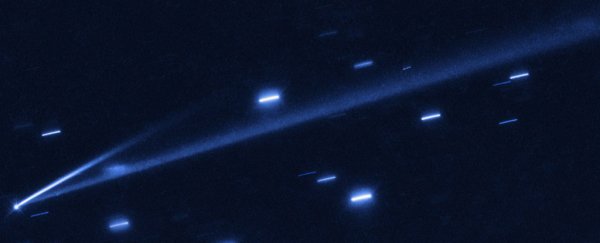The asteroid 6478 Gault first drew attention to itself for sprouting a rare double trail of dust behind it, but now it's treated astronomers to another surprise: a colour change.
Asteroids have never before been caught in the act of shifting colours like this while under real-time observation. In the case of 6478 Gault, a reddish colour is giving way to a fresh blue hue in the near-infrared spectrum, as captured by NASA's Infrared Telescope Facility (IRTF) in Hawaii.
Experts think this is happening as the dusty exterior of the asteroid gets stripped away by its continuing travels through space – and the colour change is happening quickly, observed over just two nights.
"That was a very big surprise," says astronomer Michael Marsset, from the Massachusetts Institute of Technology (MIT).
"We think we have witnessed the asteroid losing its reddish dust to space, and we are seeing the asteroid's underlying, fresh blue layers."
Around 3.7 kilometres (2.3 miles wide) and orbiting around the inner region of the asteroid belt, 6478 Gault averages a distance of around 345.6 million kilometres (214.8 million miles) from the Sun.
The asteroid's surface dust would've been burned red by millions of years of exposure to the Sun, the researchers suggest, but the outer coating may only be a few grains thick. That's now being shaken off to reveal rocky silicate material that hasn't been irradiated to the same extent.
Comets are typically known for their tails, evaporating behind them as ice is melted away by the Sun. That's not the same for asteroids – these rocky or metallic bodies formed closer to the Sun in warmer conditions, so there's not much ice left to melt.
For 6478 Gault to be producing not one but two tails, something else must be happening. The same study that spotted the colour shift also confirmed the rocky (rather than icy) composition of the object.
"It's the first time to my knowledge that we see a rocky body emitting dust, a little bit like a comet," says Marsset. "It means that probably some mechanism responsible for dust emission is different from comets, and different from most other active main-belt asteroids."
This phenomenon is originally how 6478 Gault caught the eye of astronomers. The thinking is that both the unusual tail formation and the colour shift are being caused by a fast spin (around one spin every two hours), and the centrifugal force it generates.
The spin is being put down to what's known as the YORP effect – the way sunlight can be absorbed unevenly by an asteroid, causing it to rotate over millions of years. The downside is that this fast spin is likely to cause 6478 Gault to eventually break up.
Before that happens, scientists want to confirm their ideas about the YORP effect by plotting the asteroid's brightness over time – something that won't be easy with two dust trails to peer through.
"I think [the study] reinforces the fact that the asteroid belt is a really dynamic place," says astronomer Francesca DeMeo, from MIT.
"While the asteroid fields you see in the movies, all crashing into each other, is an exaggeration, there is definitely a lot happening out there every moment."
The research has been published in Astrophysical Journal Letters.
